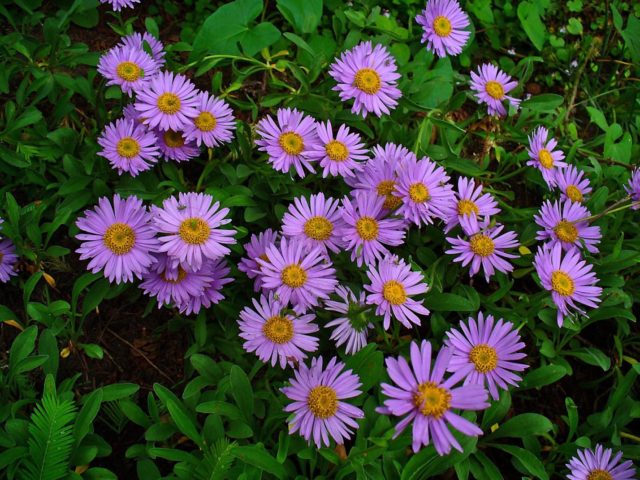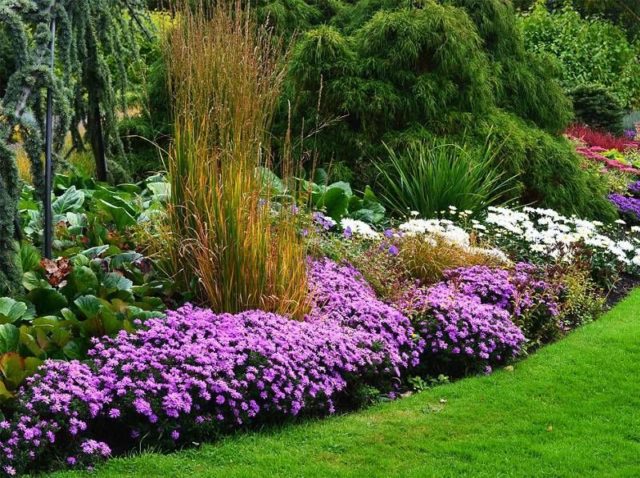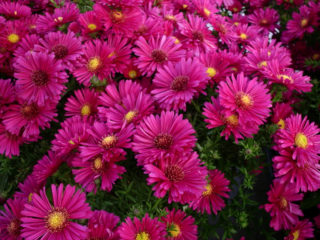Content
Shrub aster is a flowering perennial, the height of which does not exceed 50-70 cm. The bushes are beautiful, spherical in shape, densely strewn with flowers of various colors: from white to pink, lilac and deep purple. Asters are decorative, but at the same time they do not require special care.
Description of perennial bush aster
Shrub aster is a perennial plant with straight, strongly branching stems. Most often it is called bush - the name “shrub” is outdated. Bushes of medium height (up to 40-50 cm). However, there are also tall varieties up to 150-160 cm. The leaves are rich dark green, lanceolate in shape. Inflorescences are small baskets of complex structure.The tubular part is painted yellow, and the reeds (longitudinal petals) come in different shades: from white to lilac.
The size and color of the inflorescences of the bush aster largely depend on the variety: the flowers can be small (1.5-2 cm in diameter) and large (up to 7-8 cm).

The perennial aster bushes are densely covered with bright flowers, making it fit perfectly into the design of any garden.
When and how does the bush aster bloom?
About 600 species of bushy perennial asters are known, and flowering times depend on the specific variety. According to this indicator, they are divided into 3 main groups:
- early flowering – from the beginning of May to the end of June;
- summer – from the first ten days of July to the last days of August;
- autumn – bloom almost all autumn (September, October, and in the southern regions until November).
Knowing the characteristics of a particular variety, you can ensure that the garden is decorated with flowers of various colors at any time of the year:
- white;
- creamy;
- pink;
- raspberry;
- red;
- purple;
- blue;
- soft lilac.
Bush asters can also be two-colored; for example, white petals with lilac edges are often found.

Despite its small size, the bush aster always attracts attention
Depending on the form, several groups are distinguished:
- Terry bush aster: inflorescences with a large number of rows of petals: 5-7 or more.
- Semi-double: the number of rows is usually 3-5.
- Simple (non-double): all petals are arranged in 1 or 2 rows.
All these forms are used to decorate a flower garden. In design, it is important to take into account not so much the structural features as the color and height combination (tiering).
Types and varieties of bush aster
Perennial aster has many varieties and species.They differ in flower color, height and winter hardiness - these are the characteristics you need to pay attention to. Judging by reviews from flower growers, the most popular varieties of shrub aster are:
Alpine aster
It is one of the first to bloom - flowers appear at the end of May, then in June and even in July. The plant is low (up to 35 cm), the inflorescences are medium-sized - up to 5 cm in diameter.

Alpine bush aster has a very delicate lilac color
Italian aster
It resembles a chamomile in shape and can be either white or lilac in color. It reaches a height of 30 to 60 cm - this depends on the fertility of the soil and the characteristics of its care. It blooms for a very long time - from July to early September.

The classic variety of Italian aster is characterized by a soft lilac hue.
Alpine aster
It produces flowers of all kinds of colors - lilac, pink, crimson, white, purple. Bushes can be low (up to 20 cm) and quite tall (40-50 cm). Almost all varieties are distinguished by lush, long-lasting flowering.

Alpine aster looks good in single plantings
New England aster
Includes several varieties: Purple Dome, Bars Pink, Saturn, Consgans, Sunset and others. The color range is very rich: white, blue, rich lilac, with a pink tint, dark red and others. The bushes are tall, reaching a height of 120-150 cm.

Purple Dome is one of the most beautiful varieties of New England aster.
Terry aster
A very attractive bush aster with unusual lush flowers. The color is also varied - white, blue, lilac.

Due to their exceptional attractiveness, such flowers can be planted not only in a flower garden, but also in flowerpots
Application in landscape design
The bush aster is a herbaceous plant for open ground. It looks good both in single and group plantings. Therefore, in landscape design it is used in different versions:
- in combination with perennial asters;
- in joint planting with thuja, spruce and other conifers;
- in compositions with decorative cereals, chrysanthemums.
You can choose any landing location. Large bushes of lush asters, for example, terry, are planted in open spaces, green lawns, next to the entrance or bench. Low-growing bushes are suitable for multi-tiered flower beds and mixborders. Almost all bush asters look great in rock gardens and rockeries.

Bush asters are combined with ornamental grasses

Asters with lush flowers (for example, the Bessarabian variety) look harmonious on rocky ground

Planting along paths will transform any flower garden

Lush bushes can be used in single (solitary) plantings
How to propagate bush aster
Both bush and other varieties of perennial asters are easily propagated by dividing an adult bush (at least 3-4 years old). At the beginning or middle of summer, the bush is dug up, divided into several parts so that 1-2 healthy buds remain on each, and transplanted to a new place. This procedure is recommended to be repeated every 3-4 years for rejuvenation purposes.
Another method that is suitable for young and old bushes is cuttings. To obtain a green cutting, cut off the top of the stem or the entire shoot (it is better to do this in the first half of summer). It is rooted directly into the soil, consisting of the following components:
- turf soil - 2 parts;
- sand – 1 hour;
- peat – 1 hour.
First, the cuttings are grown under a film, then mulched for the winter with leaves, peat or other materials. At first, it is better to grow cuttings in a shaded place.
Seeds are planted directly in open ground in early April and covered with film. In regions with cool climates, seedlings need to be grown at home. Plants obtained in this way will produce their first flowers the very next season.

The easiest way to propagate bush aster is to divide the bush
Planting and caring for bush perennial aster
Bush aster is an unpretentious plant. It is easy to grow in most Russian regions, including the North-West, Urals, Siberia and the Far East. To ensure truly lush and long-lasting flowering, you need to take care of regular watering and fertilizing.
When to plant bush asters
Almost all varieties of bush aster are cold-resistant. They are not afraid of frost on the soil (down to -3-4 °C). Therefore, in most regions of Russia they can be planted in open ground in early May, and in Siberia and the Urals - in the middle of the month. In the southern regions, planting is allowed as early as the second half of April.
Cuttings can be planted in any summer month, preferably before August. Delenki of the bush can also be planted in June or July. And even if you do this at the end of summer, they will have time to take root.
Site selection and soil preparation
Particular care should be taken when choosing a place to plant a bush aster. It should be open, maximally illuminated and protected from drafts. Astra prefers light, loose, fairly fertile soil.If the soil is dense, it needs to be dug up, and if it is depleted, fertilizer must be added when planting.
The composition of the soil can be as follows:
- garden soil - 2 parts;
- peat – 1 hour;
- humus – 1 hour;
- compost – 1 tsp.
When planting, you need to maintain a certain interval both between neighboring aster bushes and between rows. Thanks to this, the overgrown asters will completely cover the soil and form a very beautiful flower carpet.
Distance | Varieties of asters | ||
short | Medium height | Tall | |
Between bushes, cm | 20 | 30 | 50 |
Between rows, cm | 30 | 50 | 80 |
Planting a bush aster
The further decorative effect of the bush aster depends on the correct planting. The sequence of actions is standard:
- Clear and dig up the area. Carefully break up all large lumps.
- Dig several holes at a certain distance.
- If the site is located in a lowland and the soil is often waterlogged, it is necessary to fill in a layer of drainage (small pebbles, expanded clay).
- Mix the fertile soil layer with superphosphates and potassium salt.
- Install a bush aster seedling, lay down half the soil and water generously.
- Place the remaining mixture, compact it a little and pour again.
Aftercare
The bush aster does not require special care after planting. Fertilizing should be done periodically, and sufficiently good (but not too much) watering should be provided. Another important rule is that it is advisable to replant bushes every 3-4, maximum 5 years. Otherwise, they lose their decorative effect, grow worse, and do not bloom as luxuriantly.
Watering and fertilizing
Watering is carried out evenly so that the top layer of soil always remains slightly moist.If the summer is rainy, the aster does not require additional moisture. During drought, you can water it 1-2 times a week, making sure that the soil does not crack. It is advisable to use settled water; it can be stored indoors or outdoors.

Periodic application of fertilizing will ensure lush flowering of bush aster
Seedlings need nutrients, especially during the formation of buds and the appearance of the first inflorescences. Fertilizers are applied according to the general scheme:
- In mid-May – complex mineral ones.
- At the budding stage - potassium salt and superphosphates.
- During flowering (every 3 weeks possible) - potassium salt.
- The last fertilizing can be done in mid-August. After this, it is recommended to prepare the bush aster for the winter dormancy period.
It is necessary to periodically loosen the soil, especially after fertilizing, so that nutrients quickly penetrate the roots and tissues of the entire plant. In this case, you need to loosen very carefully, shallowly, since the roots of bush asters lie directly under the surface.
Pruning bush aster
All types and varieties of bush aster require regular pruning to form a beautiful, attractive crown. Most often, the bush is shaped into a ball, removing all actively growing shoots. Tall asters are planted as a hedge - in this case, pruning is carried out every month.
Throughout the summer, especially during the flowering period, it is recommended to pinch the tops of the bush aster. This stimulates flowering - the bush produces a lot of inflorescences for several weeks in a row. It is also important to remove any inflorescences that have just begun to fade. This also stimulates the formation of new beautiful flowers.

Tall bush asters need staking
Preparing shrub aster for winter
Almost all varieties of bush aster are winter-hardy, but they still need to be prepared for the winter. To do this, in the fall, complete pruning of the ground part of the bushes (at the root) is carried out. This needs to be done 2 weeks before the first frost:
- in the Urals and Siberia - in mid-September;
- in the middle zone - in early October;
- in the south - at the end of October.
Then the bush aster is watered for the last time (no need to feed) and covered with fallen leaves (preferably dried) or spruce branches. Young, recently planted plants can be additionally covered with agrofibre (needed in regions with harsh winters).
Pests and diseases
Bush asters do not suffer from diseases as often. Fusarium and rust pose a particular danger to them. If brown spots appear on the leaves, they begin to turn yellow and wither, the infected bush asters will have to be destroyed, otherwise the infection will spread to neighboring crops.
To avoid these unpleasant diseases, it is necessary to follow certain preventive measures:
- Immediately after planting (and then every May), treat the bushes with any fungicide - it can be Bordeaux mixture, Fitosporin, Ordan, Maxim and others.
- Do not fertilize the soil with manure. It is better to use mineral fertilizers.
- If the soil is acidified, neutralize it with slaked lime in the amount of 100-150 g (not a full glass) per 1 m2.
As for pests, they rarely attack the bush aster: aphids and onion bugs can be seen on the plants. These insects are easy to destroy with any insecticide (Iskra, Aktara, Green soap, Biotlin). Folk remedies are also used - a solution of soda, ammonia, herbal infusions.

To prevent fungal diseases, it is advisable to treat bush aster with drugs
Conclusion
Shrub aster is one of the most beautiful perennial plants, blooming profusely throughout the summer and even autumn. Several hundred different species and varieties have already been created, most of which are winter-hardy. Therefore, every gardener will be able to choose a composition that is suitable specifically for his garden.








